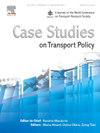Human cost, machine insight: A data-driven analysis of Australian road crashes
IF 2.4
Q3 TRANSPORTATION
引用次数: 0
Abstract
In Australia, road crash injuries continue to be a serious public health issue. Machine learning is used in this study to analyse injury data from road crashes between 2011 and 2021 that was taken from the national hospitalized injury database. We investigate how the number of injuries and duration of stay for road users are affected by variables such as gender, age, seasonal variation, collision type, and location (urban vs. regional). Road safety measures are informed by patterns and relationships found in the data by machine learning models. Hospitalizations have been trending upward between 2011 and 2019, with a pause in 2020 due to COVID-19 lockdowns. In all categories, men sustain more injuries than women, though the number varies according to age and geography. The type of road user also affects collision patterns. The time-series projections demonstrate that the goal of zero fatalities in 2050 will not be achieved under the business-as-usual scenario. The findings highlight the necessity of focused interventions predicated on collision trends and demographics. This includes better infrastructure design, increased surveillance, and customized safety measures.
人力成本,机器洞察:澳大利亚道路交通事故的数据驱动分析
在澳大利亚,道路交通事故伤害仍然是一个严重的公共卫生问题。本研究使用机器学习来分析2011年至2021年期间道路交通事故的伤害数据,这些数据来自国家住院伤害数据库。我们调查了道路使用者的受伤人数和停留时间如何受到性别、年龄、季节变化、碰撞类型和位置(城市与地区)等变量的影响。道路安全措施是通过机器学习模型在数据中发现的模式和关系来告知的。2011年至2019年期间,住院人数呈上升趋势,2020年因COVID-19封锁而暂停。在所有类别中,男性遭受的伤害都比女性多,尽管数字因年龄和地理位置而异。道路使用者的类型也会影响碰撞模式。时间序列预测表明,在一切照旧的情况下,到2050年实现零死亡的目标将无法实现。研究结果强调了根据碰撞趋势和人口统计数据进行重点干预的必要性。这包括更好的基础设施设计、加强监控和定制安全措施。
本文章由计算机程序翻译,如有差异,请以英文原文为准。
求助全文
约1分钟内获得全文
求助全文

 求助内容:
求助内容: 应助结果提醒方式:
应助结果提醒方式:


